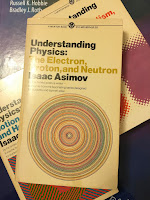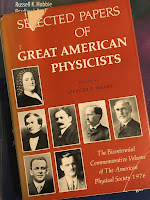 |
| Understanding Physics: The Electron, Proton, and Neutron, by Isaac Asimov. |
The experiments that determined the size of the electric charge on the electron were conducted by the American physicist Robert Andrews Millikan (1868–1953) in 1911.We don’t use electrostatic units in Intermediate Physics for Medicine and Biology (although they appear briefly in homework problem 3 in Chapter 6), but this is equivalent to 1.6 × 10−19 Coulombs.
Millikan made use of two horizontal plates, separated by about 1.6 centimeters, in a closed vessel containing air at low pressure, The upper plate had a number of fine holes in it and was connected to a battery that could place a positive charge upon it. Millikan sprayed fine drops of nonvolatile oil into the closed vessel above the plates. Occasionally, one droplet would pass through one of the holes in the upper plate and would appear in the space between the plates. There it could be viewed through a magnifying lens because it was made to gleam like a star through its reflection of a powerful beam of light entering from one side.
Left to itself, the droplet of oil would fall slowly, under the influence of gravity. The rate of this fall in response to gravity, against the resistance of air (which is considerable for so small and light an object as an oil droplet), depends on the mass of the droplet. Making use of an equation first developed by the British physicist George Gabriel Stokes (1819–1903), Millikan could determine the mass of the oil droplets.
Millikan then exposed the container to the action of X rays. This produced ions in the atmosphere within (see page 110). Occasionally, one of these ions attached itself to the droplet. If it were a positive ion, the droplet, with a positive charge suddenly added, would be repelled by the positively-charged plate above, and would rush downward at a rate greater than could be accounted for by the action of gravity alone. If the ion were negative, the droplet would be attracted to the positively-charged plate and might even begin to rise in defiance of gravity.
The change in velocity of the droplet would depend on the intensity of the electric field (which Millikan knew) and the charge on the droplet, which he could now calculate.
Millikan found that the charge on the droplet varied according to the nature of the ion that was adsorbed and on the number of ions that were adsorbed. All the charges were, however, multiples of some minimum unit, and this minimum unit could reasonably be taken as the smallest possible charge on an ion and therefore, equal to the charge on the electron. Millikan's final determination of this minimum charge was quite close to the value now accepted, which is 4.80298 × 10−10 electrostatic units (“esu”), or 0.000000000480298 esu.
 |
| Selected Papers of Great American Physicists. |
I have a personal reason for being interested in the work of Robert Millikan. According to his Nobel Prize biography, he was born in Morrison Illinois, a small town 120 miles west of Chicago, about 15 miles from the Mississippi River. This is the town I grew up in, from an age of just a few months until I was 12 years old. At the time, I didn’t realize who Robert Millikan was, or that Morrison was the home to a Nobel Prize winning physicist. But over the years I have become a big fan of “Millikan from Morrison.” According to the Morrison chamber of commerce, there is now a downtown park named after Millikan. I must go visit.



I visited Millikan Park this summer. It was fund going back to my hometown, but I was disappointed that the park didn't even have a sign with Millikan's name on it, much less a description of his role in physics.
ReplyDelete